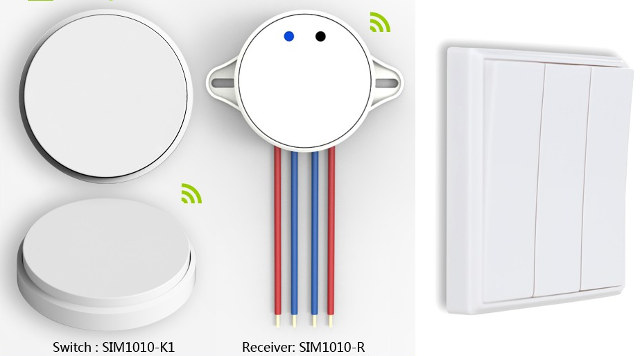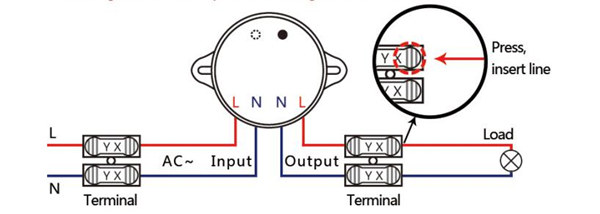SimpleLink may be the name used by Texas Instruments for their wireless MCU family, but there’s also a Chinese company called SimpleLink Technology that develops wireless smart home solutions including battery-less power switches that communicate over sub GHz band to receivers using energy harvested from pressing the button(s) on the switch.
 They have different models with 1 to 4 buttons, and round and square shapes. Let’s have a look at SIM1010-K1 specifications:
They have different models with 1 to 4 buttons, and round and square shapes. Let’s have a look at SIM1010-K1 specifications:
- Switch Type – Push-Button; operating force: 7N; typical total travel: 4mm
- Number of Keys – 1 gang
- Power Mode: Self-Powered
- Control Distance – Up to 30 meters indoor (works though walls), 100+ meters outdoor
- Frequency Bands – 433/315/868/915MHz
- Lifetime – >200,000 times
- Connectivity – SimpleLink (most probably entirely unrelated to TI SimpleLink); +10dBm Tx power
- Operating Temperature: -25~70
- Operating Humidity: 0~95%RH
- Dimensions – 70 x 15.5 mm
- Weight – 44g
That self-powered wireless switch will prevent the need to install cables between the switch and the electrical appliance or light, and communicate with SIM1010-R receiver featuring the following:
- Voltage Range – 100V-240V, 50/60Hz
- Sensitivity – -116dBm
- Controlled Power – Up to 2000W (LED MAX: 200W)
- Dimensions – 48×H25mm
- Weight – 35g

They can also provide the Simplelink self-powered module independently. The video below shows how it all works:
Since I’ve been made aware that UL/CE safely certifications might be important for this type of item, I asked the company about the receiver UL or ETL certifications to which they replied:
Because different country require different certification.We are applying CE and RoHs certification for basic use, other certification not have now.We most do OEM order, use customers’ brand, they will do the certification themselves.Also have some customers do not require certification. ( if not use in big project, to normal customers most do not concern certification )
So it looks like the product has not been independently tested for safety. It does not mean it’s not safe, it just means we don’t know.
Provided you are confident the product won’t be confiscated by the customs due to a potential SimpleLink trademark infringement, and a lack of safety certification, you can purchase a kit of comprised of a switch and receiver for $50 on Aliexpress, and they also have kits with one receiver and multiple switches. More versions can be found on SimpleLink website.

Jean-Luc started CNX Software in 2010 as a part-time endeavor, before quitting his job as a software engineering manager, and starting to write daily news, and reviews full time later in 2011.
Support CNX Software! Donate via cryptocurrencies, become a Patron on Patreon, or purchase goods on Amazon or Aliexpress





RoHs is not a safety certification, it’s about what materials are used in making the device to avoid certain toxic materials and it’s only valid for EU countries.
CE is generally a self certification where the manufacturer is responsible for any damages if anything goes wrong. It’s really quite a poor certification standard and it doesn’t come close to something like UL or the German TÜV certifications, as they test for electrical safety. This is also why many CE labelled products are actually banned locally in some European countries, as the products don’t meet safety standards.
@TLS
Never heard of CE products being banned. But the distrust in the CE label might stem from the misuse in China.
https://commons.wikimedia.org/wiki/File:Comparison_of_two_used_CE_marks.svg#/media/File:Comparison_of_two_used_CE_marks.svg
“We most do OEM order, use customers’ brand, they will do the certification themselves.”
This is baloney. Getting a UL certification has to be done at the factory, not by the OEM. This is purposely done to stop the factory from sending UL a specially built unit for testing, and then substituting in cheaper parts during production. UL will randomly check the factory production as part of the certification. There are a dozen labs offering UL/ETL certification in Shenzhen. Probably over a hundred spread out over China.
Unsafe chargers and devices are killing people — stop shipping them without doing the safety checks.
http://www.nydailynews.com/news/world/chinese-teen-dies-charging-iphone-electrocutes-article-1.1886994
In most devices it might add $0.50 to the BOM to make them safe. Part of getting UL/ETL certification will teach your engineers how to design for safety.
There is someone out there cloning your site!
Check this out
http://slietapp.appspot.com/www.cnx-software.com/2015/12/18/simplelink-battery-less-power-switch-leverages-rf-energy-harvesting-technologies/
@afrfb09ba
Over Quota
Guess they don’t have the money to pay for the bandwith though 🙂
About CE: while you can self-certify, a reputable company will have a certificate of compliance from one of the major NRTL’s (such as TUV) stating what product was tested to which standards. For industrial safety equipment, it’s typically available for download (I’ve just been downloading a bunch of these). I haven’t tried to see if these are available for consumer items.
And, if it’s a RF emitter, it will need FCC certification in the US.
BTW, China has its own standards (which can be more rigorous,e.g. gap between PCB traces is wider than CE/UL because China wants power supplies to work without sparking at unusually high altitudes).
@Marius Cirsta
appspot.com is free accounts on Google app engine. Maybe a scam to try and steal ad revenue.
@afrfb09ba
Once a site gets popular the articles always get reprinted somewhere.. But normally, but not always, Google is smart enough to know the real source.
@Jon Smirl
I think they did not understand the question, and probably thought about other certifications. I might be the sales person answering by herself too. After they’ve seen the article, they want to send one sample, so I’ll take a few pictures of the board.
@äxl
Fibaro had multiple products banned that were self certified for CE, two products in Sweden and on in Germany. Also, a lot of cheap products that doesn’t meet electrical safety standards are quite often banned for sale in Europe, even though they are CE labelled, but not always certified. CE is a joke and needs to be revised to be more in line with the US UL certification where there’s a central database that can be searched based on the CE “number” that each device should carry. As it stands, anyone can slap a CE logo on their products and consumers would be none the wiser.
I agree with the comments about UL. What most don’t know is that there many different UL certifications that can be applied to a product –so getting the correct UL certification is critical for safety and performance. They will also need to be FCC certified for low power radios (Part 15).